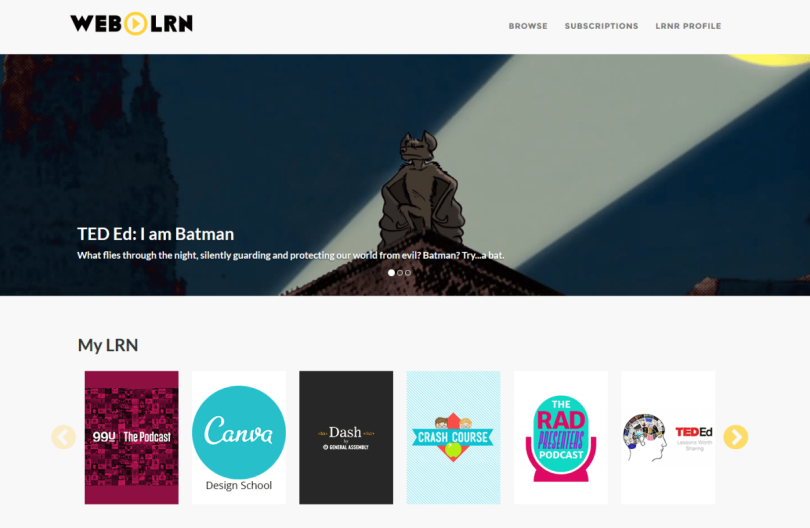As I continue on my personal instructional design journey, I consider it very important to continue to experiment with tools, technologies, and ideas. One of the ideas that caught my attention this past January was the idea of a Netflix of eLearning. I shared that idea with the AWSMPrompts community and I decided to prototype an idea myself. What I came up with was WebLRN.
The Prototype
Take a look at the prototype, built using Bootstrap and some awesome other resources (check the Credits page on the prototype site). Then come back here and take a gander at the design thinking behind it all.

The WebLRN Idea
The reasons why Netflix is so popular include the fact that it is a well-designed, easy-to-use website that allows the user to pick from a variety of shows and movies, save those to a queue to watch later, and it learns your tastes based on your past choices and ratings. Just recently, I watched and thoroughly enjoyed StoneHearst Asylum, a movie that I may have never discovered if Netflix hadn’t recommended it to me. It’s a great way to enjoy movies whenever I want, without having to worry that I’ll forget the name or the link. Learning opportunities on the web are vast and varied. There are blogs, podcasts, vodcasts, and interactive tutorials. As of right now, you might collect things that you discover on a social bookmarking site like Pinterest, which is what I often do. But as I imagined the Netflix of elearning, I considered a place that would allow you to not only collect learning opportunities that you had discovered in one place, but would also be able to suggest other learning opportunities to you. As you’ll see, my prototype of WebLRN isn’t interactive in that way; it currently just emulates the Netflix interface, but that’s the idea.
Content Curation
While Netflix pays licenses to companies to host content, I consider that a WebLRN model would link out to the learning sites, instead. Unlike movies and shows which can all be reduced to a single file type (I have no idea if this is how Netflix really works), eLearning comes in all kinds of different file types. Some are audio files, some are web pages (HTML), some are SCORM packages; you get the picture. Besides which, the individuals and organizations who create learning opportunities are typically looking get eyeballs on their website to market their services. This is not something that we’d necessarily want to take away from them. Another feature of elearning that is a little different from hosting movies and shows for the end user is that some places have subscription models that give the user access to lessons and other perks. Integrating those types of features into one marketplace would be a big job, but simply linking to it wouldn’t. In this way, WebLRN could help people discover subscriptions and free materials, rate, review, and share with others without getting into the mess of trying to deal with several different business models. Related to all of this is the question of whether or not a WebLRN type site would go out and collect different learning opportunities or if there could be some way for users to suggest learning objects to be added. I would lean more towards the latter again, just because opportunities and interests are so vast and varied. The site might employ content experts to review submissions first, but at any rate, users could be constantly growing the selection. In the WebLRN I imagine, organization would rely on both tags and categories. A user with an interest in coding should be easily able to find all of the currently indexed coding materials easily. They should also be able to separate out paid vs free opportunities, video vs. text vs online course, etc. Again, this type of organization would likely require a cooperation between users, content creators, and WebLRN content experts.
Discovery
Ideally, a site like WebLRN would have a (possibly user-created) database of learning objects from all around the web. From such a database, the site could learn what the user was interested in and make recommendations, similar to Netflix or Netflix MAX, which was a gamified and conversational way to discover new stuff to watch.
Error: VideoService could not be found
In the prototype, I channeled one of Netflix MAX’s games in order to suggest a random new thing to learn. This simple interaction was build in Storyline 2.
How Would it Make Money?
Such a complex endeavor would need to make money to keep itself clean, free from spam, and well organized. I would imagine that a site like WebLRN would make most of its money from targeted advertisements. Unless the content was being hosted and guaranteed (the way you know that, if a movie shows up in your Netflix queue, it’s there, working, and watchable), I’m not sure a subscription model would make sense. Beyond that, donations and possibly startup capital from something like a KickStarter campaign could provide further cash flow.
What Do You Think?
What do you think? Could a concept like WebLRN be sustainable? Would it be useful? Would it be a viable product? I want to hear from you in the comments.